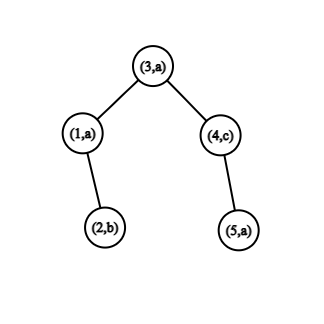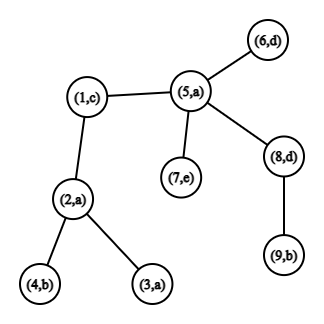Preparando MOJI
Hossam has an unweighted tree $$$G$$$ with letters in vertices.
Hossam defines $$$s(v, \, u)$$$ as a string that is obtained by writing down all the letters on the unique simple path from the vertex $$$v$$$ to the vertex $$$u$$$ in the tree $$$G$$$.
A string $$$a$$$ is a subsequence of a string $$$s$$$ if $$$a$$$ can be obtained from $$$s$$$ by deletion of several (possibly, zero) letters. For example, "dores", "cf", and "for" are subsequences of "codeforces", while "decor" and "fork" are not.
A palindrome is a string that reads the same from left to right and from right to left. For example, "abacaba" is a palindrome, but "abac" is not.
Hossam defines a sub-palindrome of a string $$$s$$$ as a subsequence of $$$s$$$, that is a palindrome. For example, "k", "abba" and "abhba" are sub-palindromes of the string "abhbka", but "abka" and "cat" are not.
Hossam defines a maximal sub-palindrome of a string $$$s$$$ as a sub-palindrome of $$$s$$$, which has the maximal length among all sub-palindromes of $$$s$$$. For example, "abhbka" has only one maximal sub-palindrome — "abhba". But it may also be that the string has several maximum sub-palindromes: the string "abcd" has $$$4$$$ maximum sub-palindromes.
Help Hossam find the length of the longest maximal sub-palindrome among all $$$s(v, \, u)$$$ in the tree $$$G$$$.
Note that the sub-palindrome is a subsequence, not a substring.
The first line contains one integer $$$t$$$ ($$$1 \le t \le 200$$$) — the number of test cases.
The first line of each test case has one integer number $$$n$$$ ($$$1 \le n \le 2 \cdot 10^3$$$) — the number of vertices in the graph.
The second line contains a string $$$s$$$ of length $$$n$$$, the $$$i$$$-th symbol of which denotes the letter on the vertex $$$i$$$. It is guaranteed that all characters in this string are lowercase English letters.
The next $$$n - 1$$$ lines describe the edges of the tree. Each edge is given by two integers $$$v$$$ and $$$u$$$ ($$$1 \le v, \, u \le n$$$, $$$v \neq u$$$). These two numbers mean that there is an edge $$$(v, \, u)$$$ in the tree. It is guaranteed that the given edges form a tree.
It is guaranteed that sum of all $$$n$$$ doesn't exceed $$$2 \cdot 10^3$$$.
For each test case output one integer — the length of the longest maximal sub-palindrome among all $$$s(v, \, u)$$$.
25abaca1 21 33 44 59caabadedb1 22 32 41 55 65 75 88 9
3 5
In the first example the maximal subpalindromes are "aaa" with letters in vertices $$$1, \, 3, \, 5$$$, or "aca" with letters in vertices $$$1, \, 4, \, 5$$$.
 The tree from the first example.
The tree from the first example. In the second example there is only one maximal palindrome "bacab" with letters in vertices $$$4, \, 2, \, 1, \, 5, \, 9$$$.
 The tree from the second example.
The tree from the second example.